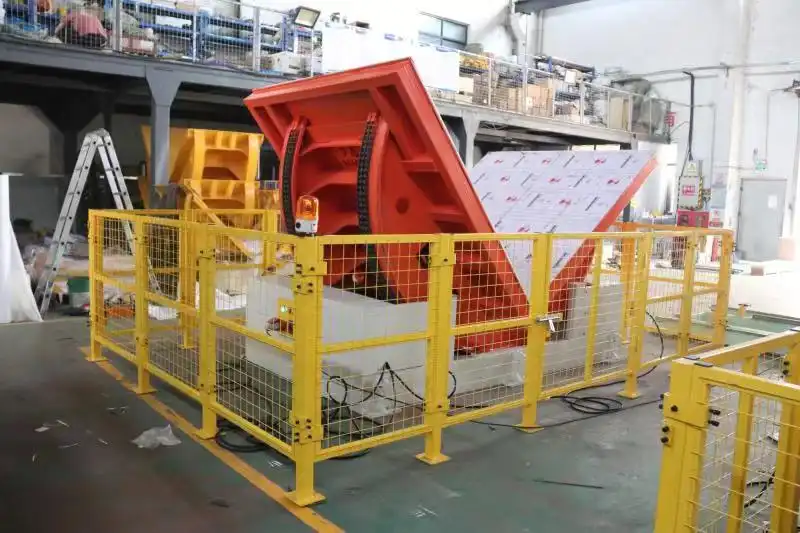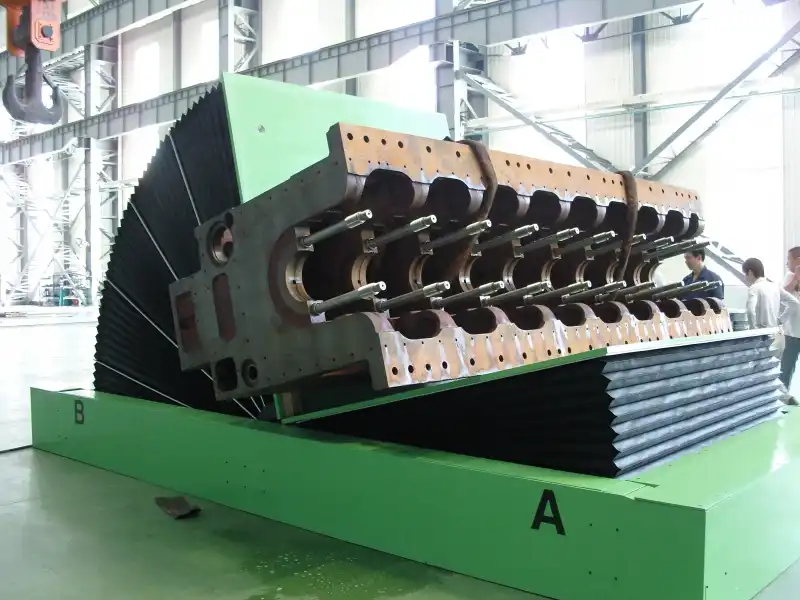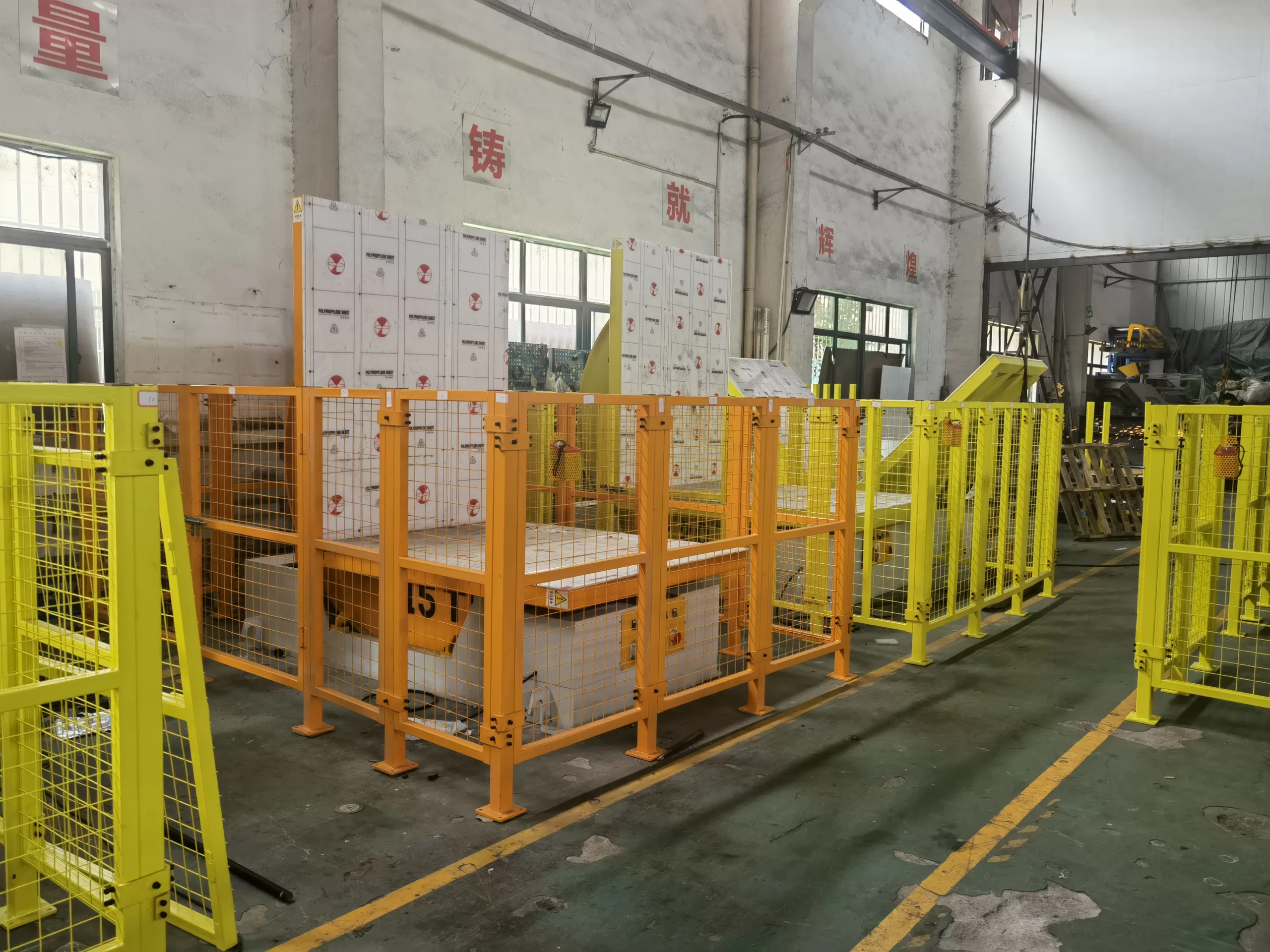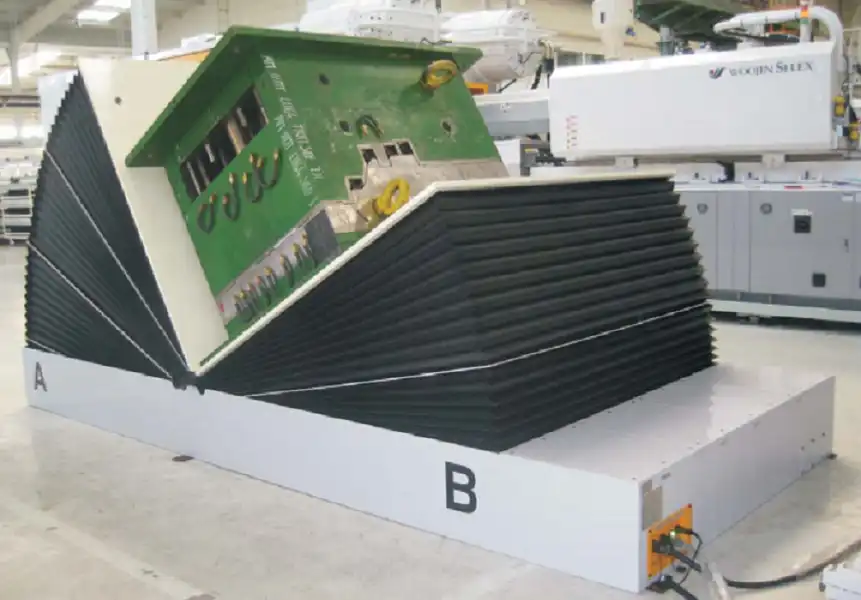Handling large, heavy molds and dies is a daily reality in factories across Mexico. For years, the standard method involved overhead cranes, chains, and a lot of manual guidance. But this method is slow, inefficient, and incredibly risky. A single moment of imbalance or a slipped chain can lead to catastrophic equipment damage, costly production halts, and, most importantly, severe worker injuries. As a factory owner, I know these risks keep you up at night. This is why a growing number of forward-thinking manufacturers are looking for a better, safer, and more reliable solution.
Mexican manufacturers are increasingly investing in hydraulic mold upenders to directly address critical operational challenges. They are choosing this equipment to significantly improve workplace safety, increase production efficiency by speeding up mold changes, and protect their expensive molds and dies from damage. An upender provides a controlled and stable method for turning heavy loads, which systematically reduces the risks and long-term costs associated with older, more dangerous handling methods.

I understand that investing in new capital equipment is a major decision. You need to see a clear return, not just a list of features. You are likely asking yourself if this machine is just a "nice-to-have" or a fundamental tool for growth and stability. In this article, I want to share my experience as an engineer and factory owner. We will look at this from every angle: the impact on safety, the real return on investment, how it fits into a modern smart factory, and what to look for in a supplier. Let's get into the details.
How Can a Hydraulic Mold Upender Improve Workplace Safety?
Using a crane to flip a multi-ton mold is a common practice, but it's one of the most dangerous jobs on the factory floor. The load is suspended in the air, creating a high-potential energy situation where any small mistake can have massive consequences. I've seen the aftermath of these incidents: crushed equipment, and worse, injured workers whose lives are changed forever. These are not just line items on a safety report; they are real people. The solution is to take the instability out of the equation. A hydraulic mold upender is engineered specifically to secure the load on a solid platform before, during, and after rotation, making the entire process inherently safe.
A hydraulic mold upender dramatically improves workplace safety by providing a stable, secure platform for rotating heavy objects like molds and dies. It eliminates the dangerous practice of flipping loads with overhead cranes and chains, which prevents uncontrolled swinging, dropping, and potential crushing accidents. This change transforms a high-risk manual task into a controlled, automated process.

Deconstructing the Safety Improvements
When I started my career as an engineer on the factory floor, I saw many "near misses." A swinging steel coil that almost hit a worker, a mold that shifted unexpectedly in its slings. These events were treated as normal. But they are not. They are signs of a broken process. A hydraulic upender is not just another machine; it's a new, safer process. It addresses the root causes of accidents in three key ways.
Eliminating Dangerous Manual Intervention
The most dangerous part of flipping a mold with a crane is the manual involvement. Workers have to attach chains, guide the load by hand, and position themselves near a suspended, unstable object. An upender automates this. The operator places the mold on the platform, steps back to a safe distance, and controls the entire rotation with a push of a button. There is no need to be near the load while it is in motion. This single change in procedure removes the primary source of human risk. The operator becomes a supervisor of the process, not a participant in a dangerous task.
Controlled and Stable Rotation
A hydraulic system provides smooth, steady, and predictable movement. Unlike a swinging chain, the upender’s platform moves along a fixed, engineered path. The speed of rotation is controlled, and the center of gravity is managed throughout the entire 90-degree turn. The machine is anchored to the floor, providing a solid foundation that a moving crane simply cannot offer. This stability is the core of its safety design. It turns a dynamic, unpredictable event into a static, controlled one.
Reducing Operator Error and Strain
Repetitive manual tasks, especially those involving heavy loads, lead to physical strain and fatigue. A tired operator is more likely to make a mistake. By automating the tilting process, the upender reduces the physical burden on your team. It also simplifies the task, reducing the chances of procedural errors. The controls are intuitive, and the process is the same every time, which builds consistency and reliability.
To put it clearly, let's compare the two methods:
| Feature | Traditional Method (Crane & Chains) | Hydraulic Mold Upender |
|---|---|---|
| Load Handling | Suspended from chains; manual rigging required | Secured on a stable, flat platform |
| Stability | Inherently unstable; load can swing or spin | Extremely stable; anchored to the floor |
| Control | Low; dependent on crane operator skill | High; precise, automated hydraulic control |
| Risk of Injury | High; risk of crushing, pinching, impact | Very low; operator is at a safe distance |
| Damage Risk | High; dropping or impact can destroy molds | Very low; gentle and controlled motion |
Investing in this equipment sends a clear message to your employees: their safety is a top priority.
What is the Real ROI of a Hydraulic Mold Upender?
As a business owner, you have to answer to the bottom line. Safety is crucial, but every major equipment purchase must be justified financially. You might be thinking, "This sounds great, but what is the actual payback period?" It's easy to see the upfront cost of the machine, but the return on investment (ROI) is often hidden in costs you are already paying every day. If a machine doesn't pay for itself by reducing costs or increasing output, it's not a smart investment. The financial case for a hydraulic upender is powerful because it delivers returns in multiple, measurable areas.
The real return on investment (ROI) for a hydraulic mold upender comes from multiple sources: reduced production downtime due to faster mold changes, lower costs from preventing damage to expensive molds and dies, decreased insurance premiums from a safer work environment, and optimized labor allocation. When you add up these savings, the machine often pays for itself much faster than expected.

Calculating the True Financial Impact
When I founded my own factory, I had to be extremely careful with every dollar. I learned to look beyond the sticker price of a machine and analyze its total impact on my operations. A hydraulic upender isn't a cost center; it's a profit driver. Let's break down where the money comes from. I helped a client in the steel stamping industry analyze this, and the results were eye-opening.
The High Cost of Downtime
How long does it take your team to change a large mold right now? Using a crane, it can often take 30 minutes or more. It requires at least two skilled workers: the crane operator and a rigger on the floor. With a hydraulic upender, one operator can safely turn the same mold in under 5 minutes. If your production line is worth thousands of dollars per hour, saving 25 minutes on every mold change adds up quickly. For a factory that does multiple changeovers a day, this reclaimed time goes directly to your production capacity and bottom line. It's not just a time-saver; it's a capacity-expander.
Protecting Your Most Valuable Assets
Molds and dies are incredibly expensive, precision-made assets. A single drop or impact from a crane can easily cause tens of thousands of dollars in damage. The repair costs are significant, but the cost of the production halt while the mold is being fixed is even higher. Sometimes, the mold is damaged beyond repair. A hydraulic upender handles these assets with a gentle, controlled motion that virtually eliminates the risk of accidental damage. Preventing just one major incident can often pay for the entire machine. This is not just a cost saving; it's risk insurance for your critical production tools.
Optimizing Labor and Insurance
The traditional method ties up at least two skilled workers. An upender allows one operator to manage the task safely. The other worker can be reallocated to a more value-added job. This improves your labor efficiency. Furthermore, insurance companies take note of safety improvements. A demonstrably safer workplace can lead to lower workers' compensation insurance premiums. While this varies by provider, it's a real financial benefit that reflects the reduced risk profile of your operations.
Let's look at a simplified ROI calculation:
| Cost Factor | Without Upender (Annual) | With Upender (Annual) | Annual Savings |
|---|---|---|---|
| Labor for Mold Turns | 2 Workers x 1 hr/day x 250 days = 500 hrs | 1 Worker x 0.25 hr/day x 250 days = 62.5 hrs | 437.5 Labor Hours |
| Downtime Cost | 1 hr/day x $1,000/hr x 250 days = $250,000 | 0.25 hr/day x $1,000/hr x 250 days = $62,500 | $187,500 |
| Mold Damage Risk | 1 incident/year @ $50,000 | 0 incidents | $50,000 |
| Total Annual Savings | $237,500 + Labor Savings |
The numbers speak for themselves. This isn't just an expense; it's a high-return investment.
How Does a Hydraulic Upender Integrate with Modern Smart Factories?
Today's most competitive factories are not just collections of standalone machines. They are integrated systems. As a forward-thinking leader, you are likely implementing digital tools like a Manufacturing Execution System (MES), IoT sensors, and data analytics to achieve total visibility and control. A new piece of equipment cannot be an "island." It must connect, communicate, and contribute data to your smart factory ecosystem. An isolated machine is a barrier to achieving goals like 95% capacity utilization and predictive maintenance. A modern hydraulic upender, however, is designed to be a team player in your digital transformation.
A hydraulic upender integrates with modern smart factories through its PLC (Programmable Logic Controller), which can be connected to a central MES. By equipping it with IoT sensors, the upender can provide real-time data on cycle times, operational status, fault codes, and hydraulic health. This data feeds directly into your production visualization and predictive maintenance platforms.

Making Your Equipment a Data Source
At SHJLPACK, our slogan is "TOTAL SOLUTION FOR WRAPPING MACHINE." To me, a "total solution" in the 21st century must include digital integration. A machine that doesn't provide data is only doing half its job. It's like having a worker who doesn't report their status. We design our equipment to be a valuable node in your factory's information network.
PLC and MES Connectivity
The "brain" of a modern upender is its PLC. We ensure our PLCs use standard communication protocols like Profinet or EtherNet/IP. This makes it straightforward for your IT or engineering team to connect the machine to your factory's central MES or SCADA system. Once connected, you can monitor the upender's status remotely. Is it running? Is it idle? Is there a fault? This information is critical for accurate Overall Equipment Effectiveness (OEE) calculations and real-time production scheduling. You can even send commands to the upender from your central system, paving the way for more automated workflows.
Data for Predictive Maintenance
Aging equipment is a major challenge. Breakdowns are costly and unpredictable. A smart, connected upender helps you move from reactive maintenance (fixing things when they break) to predictive maintenance (fixing things before they break). We can embed sensors to monitor key health indicators:
| Data Point Collected | Benefit for Smart Factory |
|---|---|
| Hydraulic Fluid Pressure | Detects leaks or pump wear before failure. |
| Motor Current Draw | Indicates motor stress or mechanical binding. |
| Cycle Count & Run Time | Schedules maintenance based on actual use, not just a calendar. |
| Vibration Analysis | Identifies bearing wear or misalignment issues early. |
| System Fault Codes | Provides specific diagnostic information for faster troubleshooting. |
This data stream allows your maintenance team to see problems developing. You can schedule repairs during planned downtime, not in the middle of a critical production run. This is essential for reaching that goal of 95% equipment uptime.
Automating the Material Handling Workflow
In a fully integrated factory, the upender can become part of a larger automated sequence. For example, an Automated Guided Vehicle (AGV) could deliver a mold to the upender. The MES signals the upender to perform its rotation. Once complete, it signals the AGV to pick up the mold and deliver it to the press. This level of automation reduces manual handoffs, minimizes errors, and further accelerates your production cycle. This is the future of manufacturing, and an integrated upender is a key building block.
What Should You Look for When Choosing a Hydraulic Mold Upender Supplier?
You are convinced of the benefits. Now comes the hard part: choosing the right partner to supply the machine. A quick online search will show you many companies that sell hydraulic upenders. On the surface, their products might look very similar, and it can be tempting to just choose the one with the lowest price. This is a mistake. Choosing the wrong supplier can lead to a nightmare of unreliable equipment, poor communication, and non-existent support after the sale. You are not just buying a piece of steel; you are investing in a long-term relationship with a partner who should be committed to your success.
When choosing a hydraulic mold upender supplier, you should look for deep engineering experience in your specific industry, a proven track record with verifiable customer references, and the flexibility to customize the solution to your exact needs. Most importantly, you need a partner who provides comprehensive after-sales support, including installation guidance, operator training, and a reliable supply of spare parts. A true partner offers a total solution, not just a machine in a box.

My Personal Checklist for a True Partner
I've been on both sides of this transaction. I've bought machines as a factory manager, and now I design and sell them. This experience taught me what truly matters. Price is a factor, but it should not be the primary one. A cheap machine that fails is the most expensive machine you can own. Here is what I tell my clients to look for.
Engineering and Customization Capability
Your factory is unique. Your molds have specific sizes and weights. Your floor layout has its own constraints. A one-size-fits-all solution rarely works perfectly. A good supplier will start by asking questions, not by sending a quote. They should have engineers who understand the forces involved and can design a machine that is not just adequate, but robust and perfectly suited to your load requirements. Ask them: Can you modify the platform size? Can you increase the weight capacity? Can you integrate the controls I need? A simple "no" is a red flag.
Quality of Core Components
An upender is only as reliable as its weakest part. The quality of the hydraulic power pack, the cylinders, the bearings, and the electrical controls is critical. A reputable supplier will be transparent about the brands they use for these core components (e.g., Siemens, Schneider, Parker). They will not hide behind generic, no-name parts to cut costs. The structural integrity is also vital. Ask about the type of steel used, the quality of the welds, and the safety factors built into the design.
After-Sales Service and Support
This is where great partners separate themselves from mere sellers. The relationship should not end when the machine is delivered.
Here is a checklist to evaluate potential suppliers:
| Evaluation Criteria | Why It Matters | What to Ask |
|---|---|---|
| Industry Experience | They understand your specific challenges (e.g., steel coils vs. injection molds). | "Can you show me case studies from companies like mine?" |
| Customization | Ensures the machine is a perfect fit for your process. | "Can you adapt the design for our specific mold dimensions?" |
| Component Quality | Determines the machine's reliability and lifespan. | "What brands do you use for your PLC, hydraulics, and motors?" |
| Warranty & Spares | Your guarantee of support if something goes wrong. | "What is your warranty period and what does it cover? How quickly can you ship spare parts?" |
| Installation & Training | Ensures your team can use the machine safely and effectively. | "Do you provide on-site installation support and operator training?" |
Look for a partner who is invested in your success for the long term.
My Insights on Why This is More Than Just a Machine
When I was a young engineer, I worked in a large packing machine factory. I saw the daily struggles and the risks people took just to get the job done. Later, when I built my own factory, I faced the same challenges as any other owner: managing costs, pushing for efficiency, and being responsible for the safety of every person on my team. These experiences shaped my philosophy. I believe that the equipment we choose to put in our factories says a lot about our values as leaders.
An investment in a hydraulic mold upender is not just about flipping a piece of steel. It is a strategic decision that reflects a deeper commitment. It is a commitment to the safety of your people, showing them that their well-being is more important than clinging to old, dangerous methods. It is a commitment to excellence, demonstrating that you value your assets and want to protect your expensive molds and dies from damage. And it is a commitment to the future, building a more efficient, reliable, and modern operation that can compete for years to come.
I was fortunate that my journey in the packaging industry allowed me to achieve success and financial independence. Now, my mission with SHJLPACK is to give back. I want to share the knowledge I gained to help other business owners, like you, grow their businesses and create safer, more productive workplaces. When you choose a piece of equipment like this, you are not just buying a machine. You are investing in a better way of working. You are building a stronger foundation for your company's future. That is a decision any leader can be proud of.
Conclusion
Investing in a hydraulic upender is a strategic move for safety, efficiency, and future-proofing your operations. It's a cornerstone for a modern, competitive manufacturing plant.





